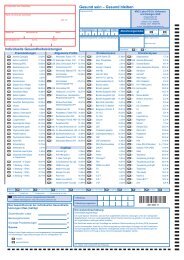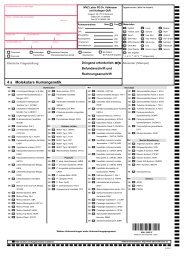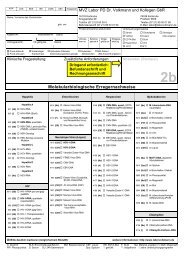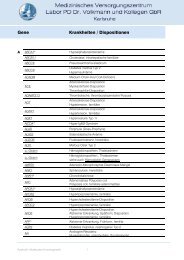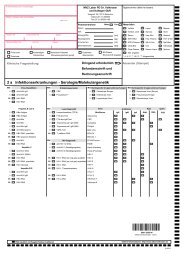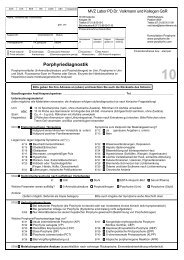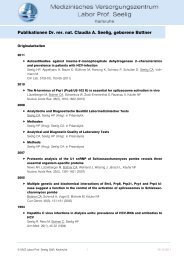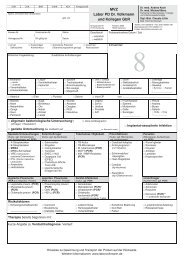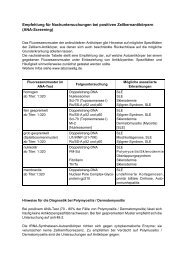ORIGINAL ARTICLE - MVZ Labor PD Dr. Volkmann und Kollegen
ORIGINAL ARTICLE - MVZ Labor PD Dr. Volkmann und Kollegen
ORIGINAL ARTICLE - MVZ Labor PD Dr. Volkmann und Kollegen
You also want an ePaper? Increase the reach of your titles
YUMPU automatically turns print PDFs into web optimized ePapers that Google loves.
H. P. SEELIG et al.<br />
Figure 4. RIPA of serial dilutions of the serum of the index patient (2), of rabbit anti-IM<strong>PD</strong>H2 Si (1), rabbit anti-IM<strong>PD</strong>H2 ih (3)<br />
and of four HCV-RNA positive sera (thin dotted lines) showing an immunofluorescence pattern suspicious of containing anti-<br />
IM<strong>PD</strong>H2. Rabbit sera were diluted with preimmune serum, human sera with that of a blood donor. All sera show a dose-dependent<br />
precipitation of 35 S-methionine-IM<strong>PD</strong>H2.<br />
rheumatic diseases and healthy controls. The cut-off between<br />
anti-IM<strong>PD</strong>H2 positive and negative patients was<br />
determined by receiver operator curves of 108 HCV-<br />
RNA carriers and 100 healthy blood donors (Figure 5).<br />
The area <strong>und</strong>er the curve (AUC) was calculated 0.762<br />
representing fairly good test conditions. The 95 % confidence<br />
interval was 0.698 to 0.819. Defining an assay<br />
specificity of 98 % the cut off was calculated at an antibody<br />
ratio (ABR) of 10.5. Under these settings anti-IM-<br />
<strong>PD</strong>H2 could be detected in HCV-RNA positive sera<br />
with a sensitivity of 35.2 %. However, there was no correlation<br />
between HCV-virus load and the presence or<br />
absence of anti-IM<strong>PD</strong>H2 in HCV-RNA carriers. The<br />
mean virus load in anti-IM<strong>PD</strong>H2 positive HCV-RNAcarriers<br />
was 1.4 x 10 6 IU/mL, mean virus load in anti-<br />
IM<strong>PD</strong>H2 negative HCV-RNA carriers was 1.6 x 10 6<br />
IU/mL. There was also no correlation between the concentration<br />
of anti-IM<strong>PD</strong>H2 (given as antibody ratio)<br />
and virus load (R 2 of the linear regression = 0.0026).<br />
As depicted in Figure 6, anti-IM<strong>PD</strong>H2 also could be detected<br />
in blood donors (2.0 %), HCV-RNA-negative patients<br />
(5.0 %), HBV-DNA positive patients (6.2 %), in<br />
patients positive for antinuclear antibodies (13.7 %),<br />
and in a high number of patients with actin antibodies<br />
760<br />
(31.0 %). The prevalence of anti IM<strong>PD</strong>H2 in patients<br />
with mitochondrial antibodies of anti-M2 type (3.2 %)<br />
was relatively low. Regarding antibody concentrations,<br />
high ABRs >20 were fo<strong>und</strong> only in HCV-RNA positive<br />
patients except for one HCV-RNA negative (ABR<br />
44.9), one blood donor (ABR 39.6) and the index patient<br />
(ABR 61.9), who also was negative for HCV-<br />
RNA. When anti-IM<strong>PD</strong>H2 positive sera (ABR >20)<br />
were retested by IIFT only sera harboring antibody concentrations<br />
of ABR >35 showed a positive immunofluorescence<br />
test with a granular pattern on in house and a<br />
“rings and rods” pattern on the two commercial HEp-2<br />
cell preparations.<br />
An ABR >20 was seen only in 11.1 % of the HCV-<br />
RNA positive patients. There were no major differences<br />
regarding age and sex of the antibody positive and antibody<br />
negative HCV-RNA positive patients. Mean age<br />
of anti-IM<strong>PD</strong>H2 negative patients was 49.6 years (67 %<br />
male, 33 % female), mean age of anti-IM<strong>PD</strong>H2-positive<br />
patients was 50.6 years (75 % male, 25 % female). All<br />
patients were subjected to a therapy of interferon and ribavirin<br />
either actually or months or years before obtaining<br />
the sera used for this screening.<br />
Clin. Lab. 9+10/2011



